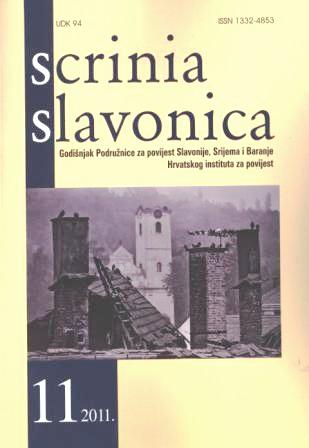Pakrački sandžak u drugoj polovici 16. stoljeća
Sanjak of Pakrac in the second half of the 16th century
Author(s): Selçuk UralSubject(s): History
Published by: Hrvatski institut za povijest
Keywords: Pakrac; sanjak; nahiye; tahrir defter; population; Ottoman Empire
Summary/Abstract: Owing to the custom of keeping detailed tax registers (tahrir defters), initiated immediately after the founding of the Ottoman Empire, during the period of building of state institutions, each conquered locality was diligently surveyed. This Ottoman practice provided us with a number of tahrir defters as a source of valuable data in historical research. Based on an exceptionally interesting tapu tahrir defter – i.e. defter recording (tahrir) titulars of the land (tapu) – number 355, dating from 1565, kept in Turkish Office of the Prime Minister Ottoman Archives, the author of this paper tries to situate the Ottoman Empire within the framework of political geography of the Balkans as well as ascertain the developmental stage of this area’s local government within the framework of Ottoman history. This and similar papers deal with a very important subject of Ottoman political history and the author holds the opinion that they will help fight the monotony in historiography on the Ottoman Empire. Balkan areas were considered Ottoman Empire’s bridge towards the West. The fact that the Ottoman Empire conquered them at the peak of its power makes them an important research subject. Pakrac area, the main topic of this research, is also important because of the Islamisation process. In order to prevent the Turkish advancement towards the West, the Christian Europe built up a defence system for its own protection, which resulted in the long-lasting war in the area. Soon after the fall of the area under Ottoman rule, the implementation of the Ottoman administrative system started to take place. The Sanjak (or Liva) of Pakrac consisted of fourteen subdistricts or nahiye: Cernik, Drenovac, Pakrac, Bijela Stijena, Kunčevac, Šagovina, Bučje, Sirač, Dobra Kuća, Čaklovac, Stupčanica, Pakarski Sredel, Klokočevac i Podvrški. Each subdistrict was a separate area consisting of villages and abandoned places (mezra). According to the recorded number of villages and abandoned places, Bijela Stijena was the biggest subdistrict in the Sanjak of Pakrac. Within the Sanjak of Pakrac there were no inhabited places bearing the mark nefs-i, i.e. the urbanised centres. The entire sanjak was, as far as it seems, predominantly rural, so the examples of urban life are scarce. The most densely populated subdistricts were Drenovac and Cernik. Generally speaking, the population of the sanjak was sedentary, although some evidence of nomad inhabitants does exist. The nomad inhabitants were organised as separate communities or congregations – (cemaat). It is interesting to observe that Muslim and Non-Muslim inhabitants lived together. The Sanjak of Pakrac was also inhabited by the Jews, but their number was not significant. This data indicates that the area was inhabited by the Christians and the Jews prior to the Ottoman invasion. Regarding the economy of the Sanjak of Pakrac, it is notable that the biggest tax income came from the taxes and work (kulluk) in agriculture.
Journal: Scrinia Slavonica
- Issue Year: 2011
- Issue No: 11
- Page Range: 61-78
- Page Count: 18
- Language: Croatian

